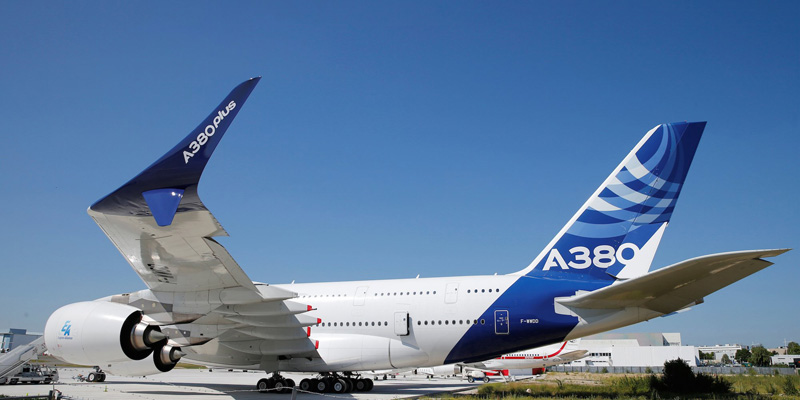There were no new orders for Airbus A380 during the 2017 Paris Air show, as had also happened in the past two years, giving rise to concerns about the future of A380. Its annual production has been progressively brought down to about 12 from 30. The lower rate can be maintained for a few more years because of a backlog. The question is: what if the order-drought continues even at the end of the backlog? The current version known also as A388 (A380-800) is the biggest passenger aircraft ever built. Given the latitude offered by its size, middle-east airlines have gone to great lengths to offer unheard of in-flight luxuries. Etihad even offers three-room suite (The Residence) with dedicated butler for those who can afford it. Low paying economy (Y) does not yield good revenue: a vacant First class (F) seat is worse than a few empty Business class (J) or many more Economy class (Y) seats.
Carriers, especially big ones, do not accept cloned aircrafts, unlike early days when airlines danced to the tune of the makers. It is the other way around now with airlines dictating not only the type of seating but even interiors and other luxuries they want installed. Only thing they do not touch is the fuselage. Even engine, which powers the aircraft, is chosen by airlines based on guaranteed performance. Choosing anything new is risky. Airlines that opted for new Geared Turbo Fan (GTF) engines for latest A320neos had to ground their fleet due to teething troubles.
Waiting for Hajj
As for A388 seating, most have opted for various combinations in three class outlays. But this does not work in markets sensitive to pricing. For that reason, Lufthansa has gone for most crowded versions of A388 for its Asian market (2 class/615 seats). It is still well below the 850 mark the Superjumbo can carry in single class configuration. It will be Holiday/Hajj charters exploiting A388 seating potential to the hilt. But this will not happen until aircrafts offloaded by airlines come into the secondary markets in the next few years.
A total of 213 A388 have been delivered against a firm order for 317 from 19 customers so far. Emirates, by far, is its biggest user, owning 95 out of 142 ordered. While buoyant Emirates is good for Airbus, the question is, what if it flies into turbulence? Having an overbearing client is not necessarily good, especially what it demands does not make a business case. Emirates has for long been pressing for A380 with new engine option (A380neo) much like neo version for smaller A320/A330s. As engine design and production is not an Airbus forte, it is crucial to convince engine makers first.
But this does not get any better with demand primarily based on a single customer—however big it may be. Engine is an expensive hardware and designing, fabricating and testing takes inordinately long. Bigger engines mean bigger problems to start with. Makers would naturally invest in one that has better business prospects assuring continuous work for many years to come. This gets even better with sale of spares and servicing in the long run. With the future of A380 under serious doubt, prospect of A380neo becomes bleaker.

Neo-liberalism has been a disaster for Nepal

Joined at hip
On A380, Airbus and Emirates are stuck together. Having heavily committed Emirates is more struck than Airbus. Prospects for A388neo will get stronger if more, far more than just 19 so far, were to order it. This is why Emirates has been putting pressure on Airbus to continue with the A380 program.
With A380neo ruled out for the moment Airbus is committed to make A380 more economical through incremental improvements. The latest derivative, as unveiled in Paris, is A380plus. It will have large winglets that will provide savings on fuel (4 percent) and bigger reduction based on seat cost (13 percent) against A388. With eight years of experience Airbus is now confident in making mandatory checks less frequent, significantly increasing utility time of each aircraft.
It has also planned to make room for additional 80 passengers by rearranging the interior. A380plus is possibly a stopgap measures that Airbus hopes will keep its clients engaged. Airbus gets sometime in the interim to ponder if a Neo version is feasible. Unfortunately, the option to append winglets on the existing frames is not on the table.
Demand figures for Very Large Aircraft (VLA) worldwide for next two decade, made separately by Airbus and Boeing, were as diverse as it could be. The Airbus figure was 1,700 with Boeing at mere 960. The huge disparity was more due to the inherent bias, one for entering and the other for exiting. The VLA domain is being progressively infringed upon by two-engined ones (A359/B778) even if with lesser range/seating.
Airlines flying A388 like what it has offered in terms of comfort and economics of operation. But as in any business they would love to see it generate more profit by being able to carry more. That was what Airbus had earlier assumed in making A388 carry heavier wings made for bigger A389. May be A388 would have been more attractive with wings that fitted it best. The future prospect for A380 is likely to be more promising as airport slots dry up and skies get more congested. It will be like going for bigger Sajha buses on Kathmandu streets than for many smaller public vehicles. May be that will eventually provide an opening for A380neo.
harjyal@yahoo.com








































